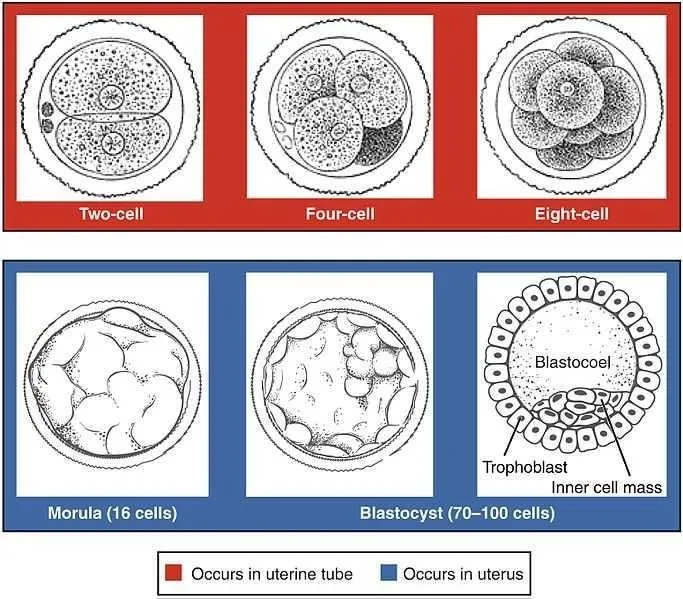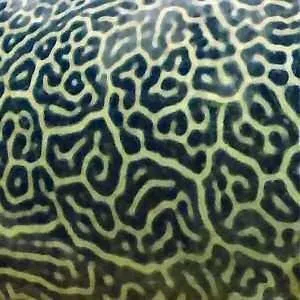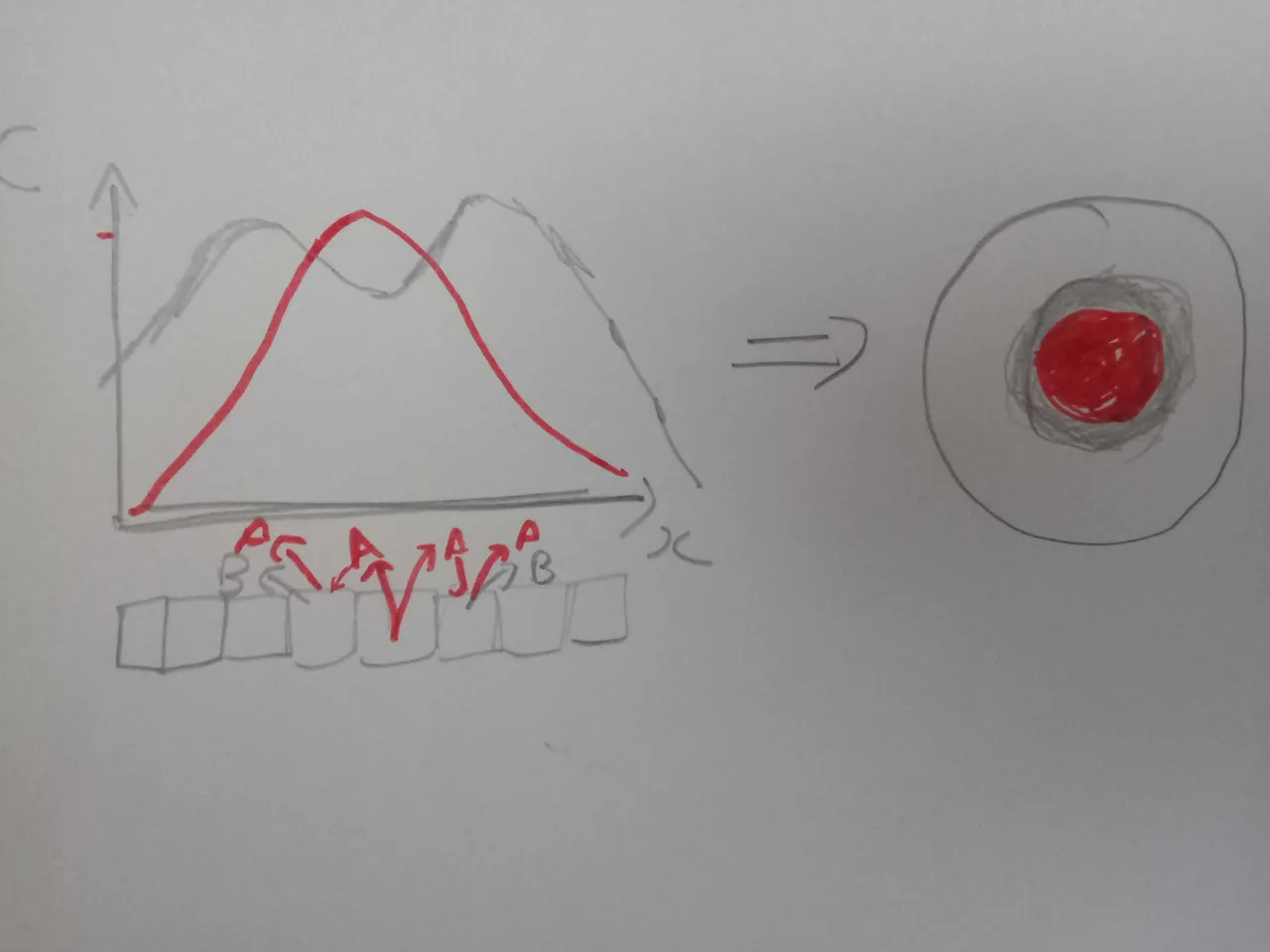
Alan Turing's statue at Bletchley Park
Source, a picture taken by Jon Callas.
CC by 2.0
Are you paying attention?
That is what you hear the star of The Imitation games asking in this movie inspired from life of Alan Turing. But were you paying attention, to the real story of this genius? The genius who not only broke Enigma code and gave us computers, but who also cracked how that round embryo turns into not so round us. This is the story of what he did exactly two years before his death.
Why are we not spherical - Symmetry breaking and Morphogens

Early stages of embryonic development.
Author: OpenStax College | source
Attribution 3.0 Unported (CC BY 3.0)
Now ask yourselves if the spherical mass of of cells in that picture, really have spherical symmetry? This is how Turing opens his 1952 paper - The Chemical Basis of Morphogenesis. He states that not every cell is necessarily the same in a spherical mass of cells. And that is true, even though morula and blastula is made of clones of zygote dividing multiple times to make this mass, you can inflict slight variations in compounds they secrete based on mere noise, or their position in the sphere, or even their position in the womb. A cell in the embryo closer wall of the uterus may secrete a different concentration of some factor than the cell distal to it. He called these factors morphogens(yes he was the one who coined this word).
Yet again, one year before Watson and Crick, Turing assumed in his paper that most genes are catalysts and their sole purpose is to catalyse chemical reactions. He goes on to say that purpose of these reactions is to yet produce more genes as a product, which are themselves catalysts. But at some point these catalysts makes a product aka morphogen which just diffuses into the tissue and forms a gradient. The morphogens in fact we know today are yet more proteins or other sinalling molecules which signal the nearby cells. The response of the cell depends on where in the gradient they lie. The gradients in fact breaks the symettry and give cells a position dependent function. So which genes these cells will express; moreover, which and how much morphogen they will make in response will depend on the initial gradient. It is indeed a chain after that where response of every cell which secretes morphogen in response to initial gradient breaks the symmetry even further.
The activator-inhibitor morphogen pairs and patterns in the chaos

Giant Pufferfish skin pattern
Author: Chiswick Chap | Source
Attribution-ShareAlike 3.0 Unported (CC BY-SA 3.0)
Turing was even more eluded by the fact that how mere diffusion gradient can create patterns. Like those patterns in the zebra stripes. Really imagine how do you make those patterns. How do you make those segmented bodies of insect? How do you perfectly shape those fingers on your hand? He proposed an elegant equation for this pattern formation. He proposed that the patterns arise by interaction of morphogens. Say, if the first morphogen causes other cells to express inhibitor of its own self at a certain, then the gradients of two morphogens will start showing regular patterns.
Say if morphogen A, which imparts red color on an animal, causes expression of itself and another morphogen B. B inturn inhibits action of A and hence its own production as well. So initially you will see that near the source cells all cells are red. And as you move further away concentration of A decreases and B starts dominating so you see a black patch. So you made your first pattern a red patch with black boundary. If you now tweak the parameters such as diffusion rate of A vs B you can make all sorts of weird patterns. Be it stripes of zebra or the distance between those hair follicles on your skin.

A simplest pattern predicted by activator-inhibitor coupled equations.
@scienceblocks
You can see more pattern formation in this video I searched for in youtube
The morphogens became the key to all developmental biology as we know today. Morphogens does two things it gives your cells positional information. Like how do cells know if they made the hand long enough from the elbow and it's time to start developing the palm and fingers. A combination of morphogens can cause regular patterns, telling your cells how to actually pattern fingers or when does that artery bifurcate. Infact Turing patters not only explain development of embryos but also how population of animals disperse on the ecosystem(Hata et al., 2014).
However, not every pattern might result form direct activator inhibitor model of turing. The other mechanisms can be gene acting as binary switches based on concentration of morphogens. Then other patterns like those random patches on cat fur, can result from random choices of X-inactivation that happens in the cells. Nevertheless, for most part Turing mechanism was key to finding all variations by which morphgens create patterning and development of embryos(Atleast for all morphogen dependent patterning).
Sadly, Turing died two years after publishing his first paper in biology. I mean imagine if not for those barbaric laws against homosexuals at that time, and that hormone therapy he had to go through, what all he could have given to humanity. In fact, if you think the idea of simulating biological systems on computers is new, you may want to read more about this paper. Given enough time and resources, who knows, if Turing would have been able to simulate real embryonic development on his computer.
Finally I will leave you for now with a question you can try to answer. If genes determine morphogens and their gradients then why do monoplacental and monozygotic(identical twins who shared the same maternal environment and same genes) have different fingerprints? Or for that matter why don't arteries bifurcate at the same length in these twins? I will reward the 1st correct and interesting answer with 2 shares of steembasicincome.
Bonus videos
References
Signing off
@scienceblocks
